
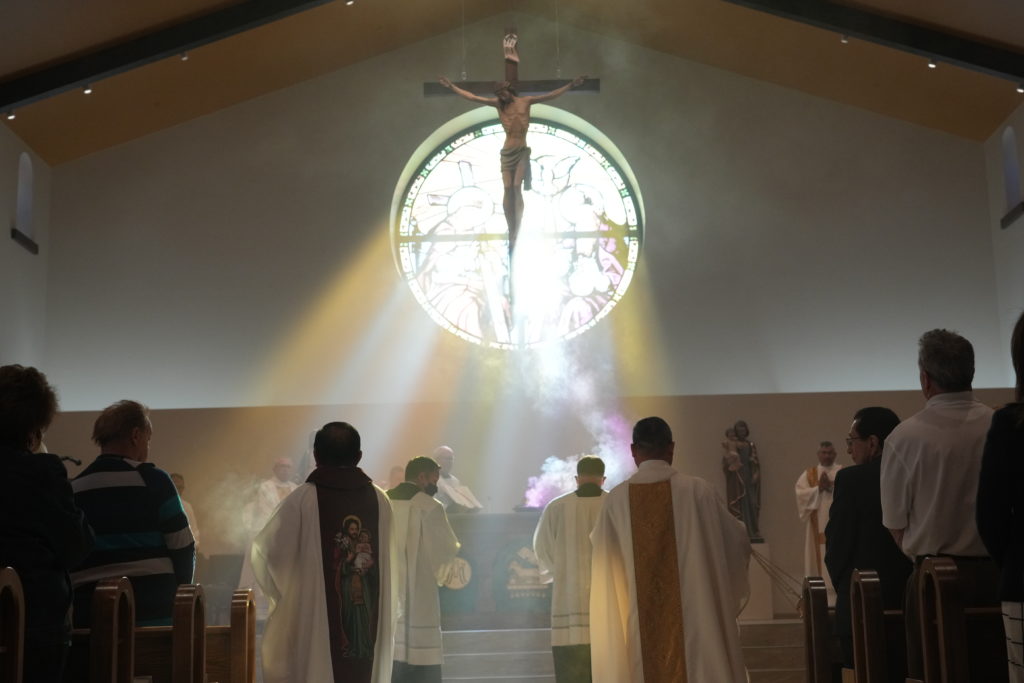
By Tony Gutiérrez, The Catholic Sun
St. Joseph Parish in North Phoenix has much in common with the mythical bird that is the namesake of the city where it is located. After a devastating fire burned its former church to the ground May 1, 2019 — the Feast of St. Joseph the Worker — a beautiful new structure now stands in its place.
“Doesn’t a sacred building as beautiful as this inspire us to love Christ with fresh enthusiasm?” asked Bishop Thomas J. Olmsted during his homily when he dedicated the new church Jan. 8. “What happened in the less than three years since the fire is a testament to the power of Christ at work in a community of people alive in faith.”
Macbeth Torno, a member of the parish’s Filipino community who has been attending St. Joseph since the late 1980s, remembered seeing the aftermath of the fire as firefighters were putting it out, tearfully telling the Sun at the time that it was a “true devastation.” Being able to worship in the new church was emotional for her, she said, to see the fruits of the community working together.
“This is my first time to witness something like this in my being 71 years old,” she said. “I just hope that this will inspire people that there is hope.”
Torno said the Filipino Club of Arizona and the Phoenix Phil-Am Lions Club of Arizona were among the organizations that helped fundraise to support the new building.
Members of the parish’s St. John XXIII Knights of Columbus Council 7159 also helped support the building fund, donating $10,000 from their various fundraisers throughout the years. Grand Knight Frank Atherton said the “troops mobilized really quickly” to help any way they could.
“It’s been a long time coming, but it was worth the wait,” said Grand Knight Frank Atherton. “It’s like being able to come home — to get out of a temporary building and come to our home, which in this case is St. Joe’s.”
From the beginning, the rebuild was entrusted to St. Joseph, said parochial administrator Father Reggie Carreon. That most of the construction happened during the Year of St. Joseph is fitting, he said, noting that the parish did a consecration to St. Joseph during the year, and he also did one independently.
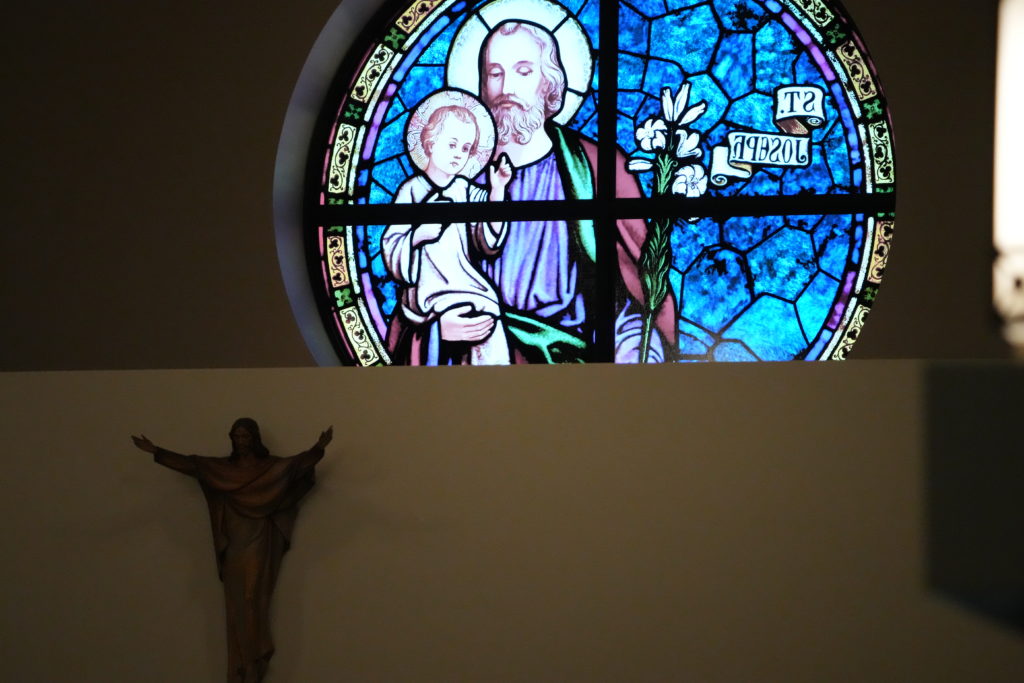
“That’s why in the Year of St. Joseph we took advantage. We prayed the consecration of the parish to St. Joseph with that book of 33 days of prayers,” he said, referencing “Consecration to St. Joseph: The Wonders of Our Spiritual Father” by Father Donald Calloway, MIC. “A good effect, even if there were a lot of problems, especially with the permits and with the clearances and with the money, the selection of the right architect, … in the consecration to St. Joseph, all these were given solutions.”
The outside of the church is accented in turquoise — both a nod to the Southwest region and to the fact that St. Joseph is associated with the color green because it symbolizes his faithfulness to God’s call. The ceiling of the church is painted in wood tones, emblematic of St. Joseph’s profession as a carpenter.
Pat Edwards, co-chair of the Rebuild Committee and chairman of the Parish Finance Committee, said these designs were intentional. Also an architect, he worked closely with the hired architect as the designs progressed.
“In my 40 years as an architect, I’ve done some amazing projects around the world. I’ve done billion-dollar projects, and I’m proud of a lot of them. This one is by far and away, my proudest project,” said Edwards, who has been a parishioner for 25 years. “To see this church, there was nothing but ashes before. Now we’re sitting here two-and-a-half years later… we have a beautiful church.”
Meredith Sánchez-Castillo, who has been attending St. Joseph for 24 years since she was 11, said she felt the Holy Spirit as she read the Second Reading for the liturgy.
“It’s honestly a very surreal experience, and I just feel so blessed to be a part of this community,” she said.
Sánchez-Castillo is a member of Young Catholic Professionals, who also claim St. Joseph as their patron. She said that everywhere she goes, St. Joseph is a part of her life, noting the St. Joseph’s chapel she attended when she went to the College of the Holy Cross in Worcester, Massachusetts.
“In every little corner of my life there’s always St. Joseph somewhere,” she said, “so, I just feel like he’s the spiritual father guiding me and my community. Through his intercession, I’ve just been so blessed in my life.”
Since the fire, the community has been worshipping in the parish hall — renamed St. Joseph Ascension Hall when the parish celebrated its 50th anniversary just a little more than three months later. The hall had been a set of several classrooms, but some walls had to be demolished to allow for a larger worship space.
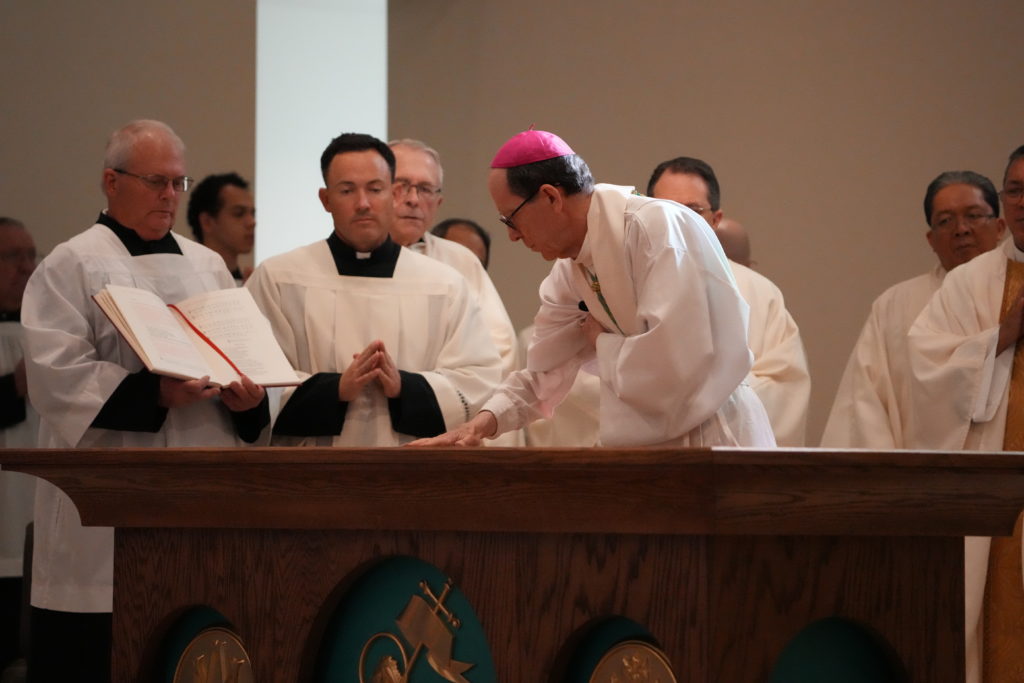
The tabernacle in the sanctuary and the monstrance in the Adoration chapel are a part of the original church. The tabernacle was slightly damaged, but it was able to be repaired, while the monstrance needed some cleaning. Embedded in the flooring in front the tabernacle are some burned remnants of the old church, serving as a foundation for the new church. This includes pieces of the old ciborium, a crucifix, and some medals, among other items.
“We put some remnants of the fire and put them just in front of the tabernacle,” Father Carreon said. “They represent the old church.”
Another plan to remember the old church is in the works, Father Carreon said. He hopes to put up some kind of edifice, either inside or outside the church, that contains some burned items that have maintained their form.
“We are planning a little edifice to put all the different items that we have that are still in good form, especially the statue of the blessed Virgin Mary. The form is still there — the face, the body — but all in black,” he said.
Other remnants include a large crucifix and a large rosary. One parishioner brought over a bag of ashes that had flown onto his property the day of the fire to be used for Ash Wednesday, as they come from a consecrated building.
The relic in the altar is one of St. Pius X, who, as pope, wrote the “Prayer to Saint Joseph for Working People.” The relic was taken from the home of the late Father Frank Fernandez, who served as pastor of St. Joseph 1995-2010.
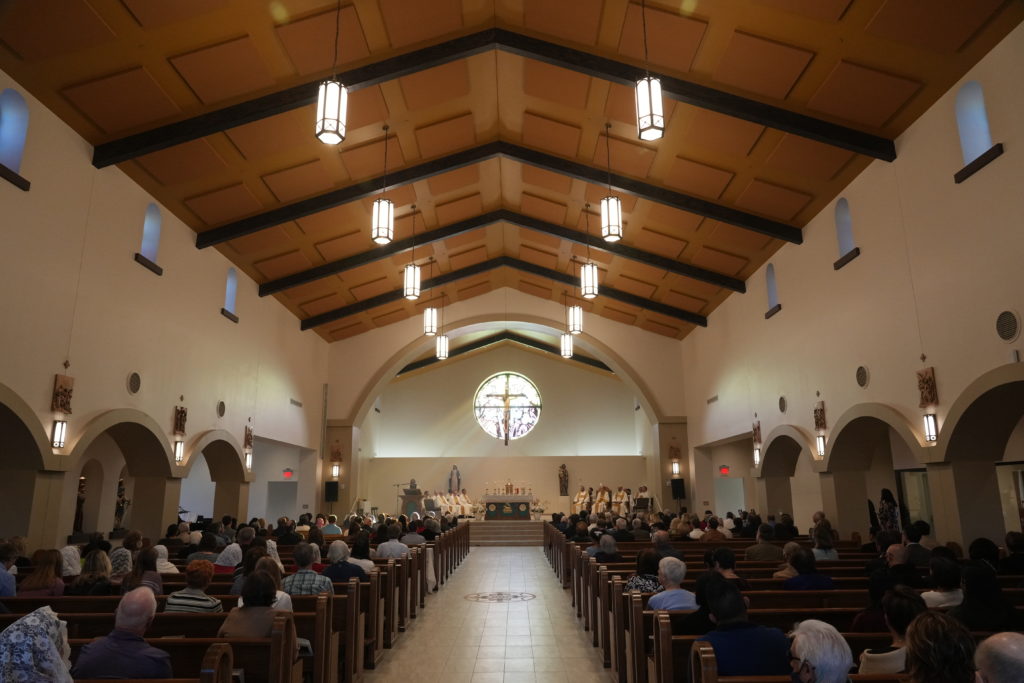
The church is built with a cruciform footprint, a traditional design meant to point the faithful to the altar and to reflect on the Eucharist. Two large rose windows are placed high — one of St. Joseph at the entrance and another of the Holy Trinity in the sanctuary. The high roof and bell towers can be seen from the street, serving as a witness to the community.
“It is a wonderful thing for this parish to have a home like this and to be so visible from the street,” said John Minieri, Director of Real Property and Facilities for the Diocese of Phoenix, who has assisted the parish throughout the rebuilding efforts. “It’s been a real joy because the people here at the parish were very dedicated.”
In his homily, Bishop Olmsted commended parishioners for not fixating on their loss and for trusting in Jesus.
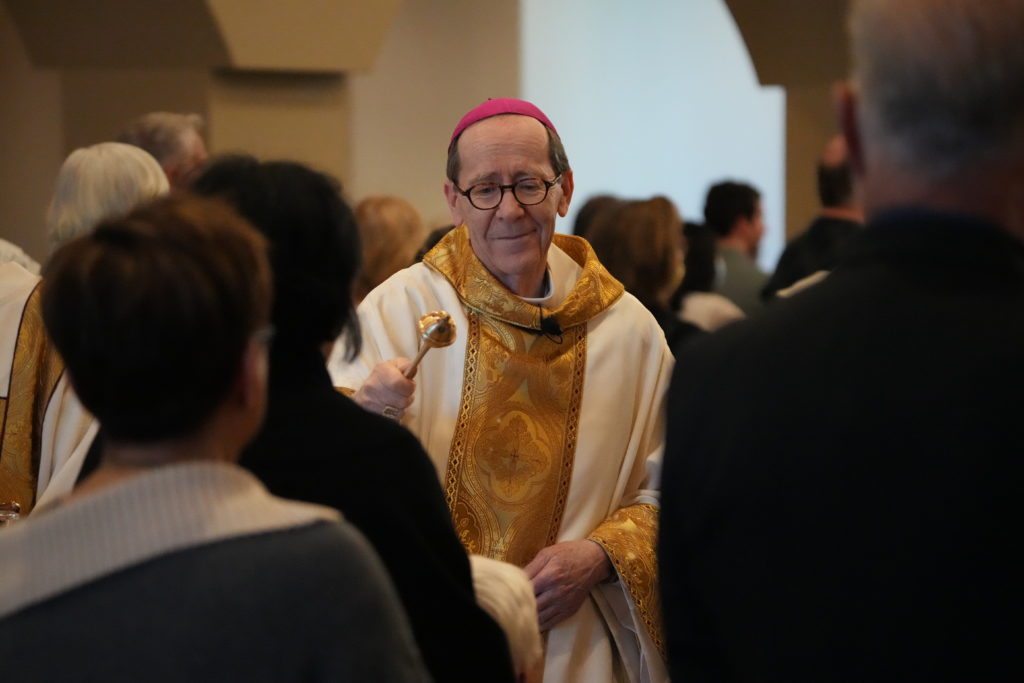
“Of course, you mourned the great loss; you wept at the memory of so many momentous sacred events that had transpired in the former church and would never happen there again. But you did no remain mired down by the loss,” he said. “What the pastor and people of the Parish of St. Joseph have done by constructing this magnificent church building is far more than building an edifice of steel and mortar and stained glass.
“With God’s grace, you have conquered discouragement. You built something beautiful for God and for generations to come,” he added. “What happens in this building will attune hearts to the needs of our brothers and sisters. For the Lamb of God whom we encounter here in Sacred Mysteries will be our strength. He will fill our hearts with love, so that we may give it away with joy.”





